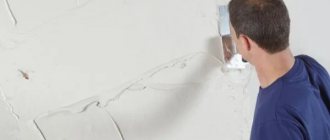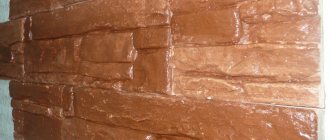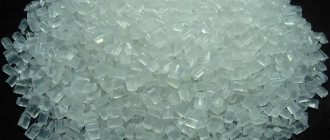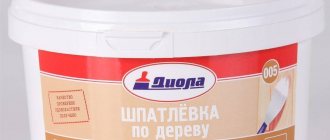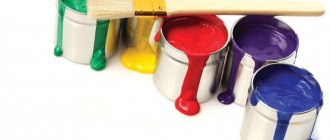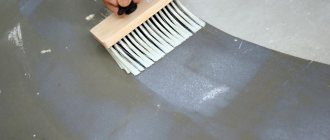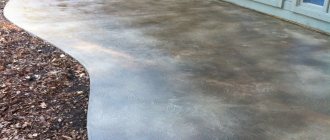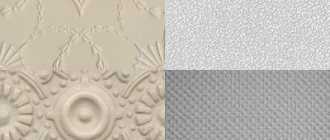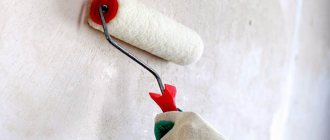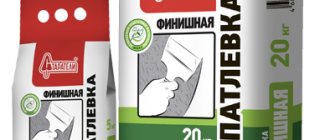The use of cement mortar is widely used for external and internal work. The standard color of this solution is gray. To give a decorative look, the cement surface can be painted in different colors or at the stage of preparing the solution, add a cement dye to it - this will give the solution a more saturated and uniform color.
Adding pigments to the solution extends the service life of the painted cement surface. If you paint gray concrete, then this decorative layer will last a long time.
In what cases is a colored solution used?
Various outdoor structures that have an original appearance are made from colored mortar. This cement is used to make borders, flower beds, paving slabs or decorative stones for paving paths.
Coloring agents are added to the solution during preparation or hardening. It is better to use the first method, in which case the composition will be painted evenly, and the product will not discolor even when washed. This method will be more expensive than the second option, but it is of higher quality. If painting is done exclusively on the surface, it tends to wear off over time, so additional finishing of the product may be necessary in the future.
Criterias of choice
The correct choice of dye will affect the resulting color and quality of the product. Before making a purchase, experts recommend paying attention to some characteristics of the composition. A good product must have:
- resistance to alkaline concrete environment;
- light and weather resistance;
- high coloring power.
When purchasing ready-made mixtures from trusted manufacturers intended for concrete surfaces, you don’t have to worry about stability. It’s another matter when such a dye is prepared independently at home.
Almost all high-quality products are characterized by good resistance to weather conditions: humidity, temperature changes and high solar activity.
The percentage of dye in concrete should not exceed acceptable standards, since excess will negatively affect the material itself. READ Paint for concrete: types of wear-resistant materials for outdoor work
The coloring power of a composition almost always depends on the fineness of the pigment. Finer particles will penetrate the material better. Another important feature is that the pigment must firmly adhere to the cement, enveloping its particles, and not dissolve in water. This will improve color fastness. This characteristic should be taken into account by all those who want to independently prepare a concrete dye for paving slabs and other products.
Factory-made formulations meet all these requirements, but those prepared at home may be inferior in certain properties.
Types of dyes for cement
All pigments for cement structures are divided into the following types: dry, semi-liquid and liquid. Mostly dry colors are used, which are mixed with a solution, but they do not react with liquid. Such pigments are resistant to humidity, washing off, and fading.
Dyes can be organic or mineral based, and they can be artificial or natural, depending on their origin. The most famous are natural pigments; they are processed mechanically. Mineral raw materials, that is, ocher or umber, are processed thermally.
Adviсe
Advice for users will be as follows:
- before diluting the pigment, it must be sifted through cheesecloth, and the solution must be strained;
- you need to know the compatibility of pigments, as some do not combine;
- burnt bone, red lead, chromium oxide, umber are mixed with all dyes;
- adding pigment to the cement mixture is carried out until the color intensity stops, this is about 4-5% of the cement mass, there is no point in adding further, otherwise it can cause harm by reducing the strength characteristics of the solution.
Painted masonry mortar looks beautiful. There is a contrast between the seams and the bricks, improving its perception. This option is suitable for indoor and outdoor masonry.
Main features of color for cement
The color for cement is made at high temperature, only in this way the natural material will give the required color. With the help of such dyes they imitate any materials.
When painting cement, the surface can be plastered with a certain color, so that stains and defects will be invisible due to the uniformity of the shade.
But you need to know that if the pigment is not mixed correctly with the solution, salt will appear on the surface of the constructed product over time. To avoid this, you need to follow some rules.
How to work with pigments correctly
The cement is given a certain color even before the solution is mixed. The color is added to the cement, and then a mortar is made to construct the products.
Before adding the dye, the cement must be well prepared; it should not contain unnecessary impurities and lumps. For high-quality cleaning, you can use a sieve to sift cement.
There should not be too much dye in the composition, usually its indicator is about 2% of the total cement, in extreme cases, this figure can reach 5. The more color is added, the richer the color of the cement will be. Therefore, it is better to add color gradually so as not to add too much.
When preparing cement, sand is used, and the solution may lose color. To prevent this from happening, use white quartz sand. This material has a high density and is distinguished by its binding properties, thanks to which the solution product will be strong and durable.
The solution must be mixed perfectly so that the pigment is distributed evenly throughout the mixture. You can use a concrete mixer for mixing, as this is difficult to do manually. If it is necessary to mix a small amount of solution, this can be done using a drill with a special attachment.
If the solution will be prepared manually, use clean available tools to mix it. To mix the composition perfectly, it is prepared in small parts.
Do not apply multiple thick layers of colored cement as the color may deteriorate. If you are constructing a colored cement structure, you must wait until each previous layer has dried thoroughly. The next layer can be applied after 4 hours.
In order for the painting to be uniform and sufficiently durable, it is necessary to use Portland cement; it adheres well to the pigment. Due to this, the completed structure will not lose color from the sun and will not be washed off with water.
Characteristics of additives for the working mixture
The dye for the solution is diluted using solvents. They are selected depending on the substances contained in the base:
- White spirit dissolves alkyd resins well.
- Water is mixed with acrylic dyes.
- Acetone comes into contact with nitro paints.
- Drying oil interacts with oil-based pigments.
Among the main characteristics of pigments are:
- Fraction size is the most important indicator of any dye, characterizing the ability to cover the surface being painted. As the particle size decreases, the reliability of repainting increases;
- sensitivity to light, characterizes the ability of a surface coating to maintain color depth and not fade;
- oil absorption capacity - an indicator that determines the ability of a composition to hold a certain volume of oil;
- alkali resistance determines the ability of the pigment to contact cement;
- hiding power is a characteristic that determines the ability to cover the surface being painted.
How to choose the right color for cement
If all working rules are followed, cement with the required shade is obtained, the solution is durable, strong, and resistant to fading, wear, washing off, tolerates low temperatures, and aggressive environments. Using a cement tint, you can obtain the desired color of the solution.
The color must be chosen from a well-known brand to avoid artificial materials. At the same time, the quality of the colored cement will be high. The color must contain latex, so you need to read the packaging when purchasing. Thanks to this substance, the solution will be easier to apply, and the color will be durable. Thanks to latex, the plaster is flexible and strong.
The consistency of the color should be uniform, and the cement for the solution should be fine-grained. In this case, the color of the solution will be uniform, without defects or stains.
How to prevent efflorescence on surfaces
Efflorescence is the name given to emerging white spots that spoil the appearance of a finished wall. To prevent the appearance of such stains, you must adhere to some rules:
- The cement should only be clean, without unnecessary impurities and lumps.
- When working, use purified or soft water.
- The concrete structure should be kept for about two days until it hardens to a minimum.
- Finished products must be laid on material that absorbs moisture.
- If efflorescence does appear, then acidic substances cannot be used to remove it.
To remove white spots, special silicone impregnations are used, which penetrate deep into the pores of the material and prevent the appearance of efflorescence. Sometimes light stains can serve as a decorative element on the surface.
Process of painting concrete after curing
Many developers who have not encountered painting concrete are interested in how to paint the cement mortar after it has set, dried and acquired the required hardness?
This possibility exists and is used to cover ready-made, monolithic structures made of ordinary and reinforced concrete. The method is the process of applying a layer of paint to the surface of the finished product. A special composition must be used that penetrates deeply into the pores of the concrete surface. The composition forms a coating on the concrete product and penetrates into the concrete mass by more than 5 mm.
The technology has proven itself positively when painting large areas and performing facade work. The preservation of the color of a concrete product is determined by the ability of the substance to penetrate deeply into the base and its hydrophobicity (moisture resistance) after hardening.
With increasing depth of penetration of the composition containing pigment dye, the service life and color saturation of the surface increases. After all, the top layer will be under the influence of natural factors that have a detrimental effect on most coloring compositions.
The ability to resist abrasion is an important point. As the top layer wears, the paint will be removed. That is why manufacturers of paving slabs paint the cement mixture, and not the finished product.
Basic color requirements for cement
- The main requirement is the fineness of the grinding; it must be fine, then the tone of the structure will be rich and uniform.
- The powder must have a high ability to paint over cement.
- The color must be resistant to alkalis contained in cement.
- The material must be able to hold up to 100 units of oil on the surface. The lower this indicator, the more economical the consumption and costs.
- High-quality color has high light fastness. The surface of the structure is resistant to fading in the sun. Colors of natural origin are of higher quality and do not lose color unlike synthetic materials.
- It is better to use brands from well-known manufacturers to avoid fakes and low quality materials.
- If you dye the solution yourself, you do not need to mix all the material with the pigment at once. First you need to do a trial job and eliminate all shortcomings. It must be taken into account that if the color is added excessively to the composition, cracks may appear on the surface in the future. This happens because the pigment absorbs moisture from the concrete. To eliminate this problem, it is necessary to add a plasticizer or special substances to the solution that retain moisture.
Variety of materials
Dye for concrete or paving slabs is sold in the form of a powder, liquid or additive.
Powdered dye Source alicdn.com
Each of the samples is suitable for use in certain conditions and has its own range of shades. Toners are also distinguished according to their intended purpose with respect to the additional impact on the finished product.
Acrylic
Ready-to-use paint is made on the basis of acrylic binder. The composition is used for work indoors and outdoors. The material is applied to the concrete base with a brush, roller or spray gun. To obtain a more pronounced shade, it is recommended to carry out two-layer staining.
Acid
The composition is sold in powder form. This is the most popular type of dye. There are only 8 ready-made color solutions. You can mix pigments with each other to obtain other shades. It is also permissible to make changes to the manufacturer’s recommended recipe. The advantages of materials include resistance to fading, richness and durability.
Examples of adding color to concrete;
- white – titanium dioxide;
- black – soot, carbon monoxide;
- green – chromium oxide;
- red – iron oxide;
- yellow or brown – iron oxide.
To obtain the most predictable results, it is worth mixing a composite based on white cement.
White cement Source expertfasada.ru

